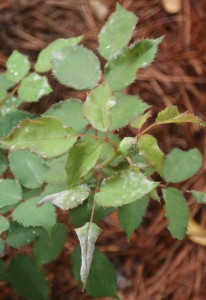This spring powdery mildew has been prevalent on many non-resistant cultivars of ornamental plants, particularly rose and crapemyrtle.
Ideal conditions for powdery mildew development, warm days and cool nights followed by rain, have been present for several weeks in Northwest Florida.
This fungus, which looks like powdered sugar and is caused by several different species, appears on new growth and causes distorted and stunted leaf and flower development. It grows in thin layers on the surface of leaves and reproduces by spores.
Mild cases are of little concern, as most plants will grow out of it once environmental conditions change to be less favorable for development of the pathogen. Severe cases can cause distorted growth, leaf drop and flower destruction.
In these cases, fungicide application will protect new growth from this disease. Some lower toxicity fungicides that have been shown to have effectiveness on powdery mildew include neem oil and potassium bicarbonate (otherwise known as Baking Soda).
Sulfur can be used, but cannot be applied when temperatures reach above 90 ° F. Other chemical fungicides, including those containing myclobutanil, or azoxystrobin can be used but products obtained must be labeled for ornamental use. Remember, the label is the law.
Many disease resistant cultivars of rose and crapemyrtle exist, please follow the links provided for more information.
- Woodland Pinkroot Adds Vibrant Color to Spring Landscapes - April 27, 2023
- Easy Care Roses for the Gulf South - April 20, 2023
- Herb Gardening: When Oregano is Flavorless - March 9, 2023




